If you’re a bird watcher, you’ll want to check out the geese in Kansas. There are all sorts of different species, and they can be found pretty much anywhere there’s water.
What Geese Are in Kansas?
There are a few different types of geese that can be found in Kansas.
- Canada Goose
- Snow Goose
- Ross’s Goose
- Cackling Goose
- Greater White-fronted Goose
Two swan species also live in the state of Kansas – Tundra Swan and Trumpeter Swan.

Canada Goose


Canada Goose Sound
Scientific Name: Branta canadensis
Length: 30 to 43 in
Wingspan: 50–73 in
Weight: 5.7–14.3 lb
The Canada Goose is a large, well-known species of waterfowl noted for its distinctive appearance, familiar “honk,” and migratory behavior.
Appearance: Both male and female Canada Geese have a similar appearance, featuring a black head and neck with distinctive white patches on the cheeks and chin. The body is primarily brown with a lighter, often white, underbelly.
Diet: Canada Geese primarily feed on plant matter, including grasses, aquatic vegetation, and grains. They can often be seen grazing in parks, lawns, and fields, as well as dabbling in water bodies.
Reproduction: Canada Geese typically nest on the ground near water bodies, often on islands or other isolated areas to avoid predators. The female lays a clutch of about 4 to 6 eggs, which she incubates alone for around a month.
Snow Goose

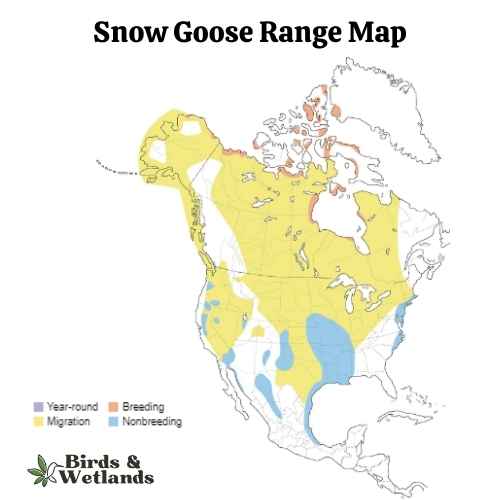
Snow Goose Sound
Scientific Name: Anser caerulescens
Length: 25 to 31 in
Wingspan: 53 to 65 in
Weight: 4.5 to 6.0
The Snow Goose is a large species of waterfowl known for its vibrant white plumage and significant migratory flights.
Appearance: True to their name, Snow Geese are predominantly white with black wingtips. They also have a pink bill, pink legs and feet. A color morph, known as the “Blue Goose,” displays a bluish-gray body with a white head, but is considered the same species.
Diet: Snow Geese primarily feed on plant matter, such as grasses, sedges, and small grains. They can often be seen in large flocks foraging in fields and marshes, and during migration and winter, they can cause considerable damage to agricultural fields due to their feeding habits.
Reproduction: Snow Geese typically nest on the tundra, near water bodies. The female builds the nest and lays a clutch of about 3 to 5 eggs, which she incubates alone for approximately three weeks. Once hatched, the goslings can feed themselves but stay with their parents for protection until they can fly.
Ross’s Goose
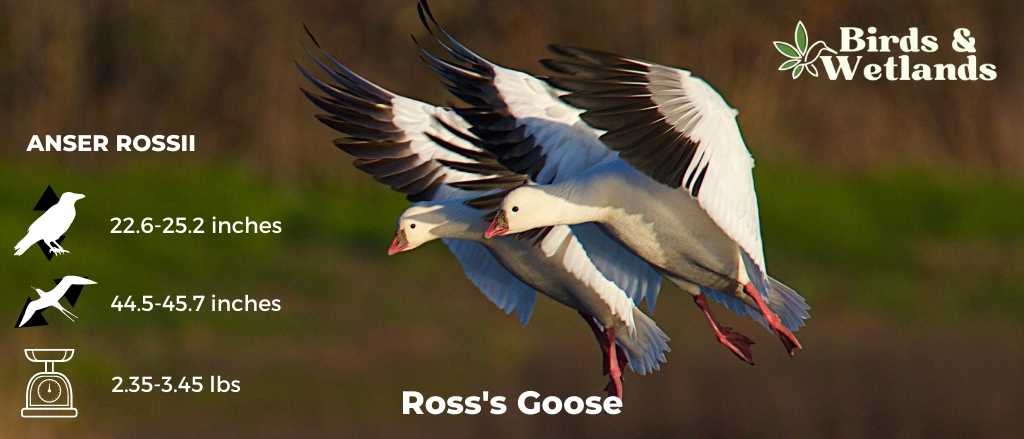
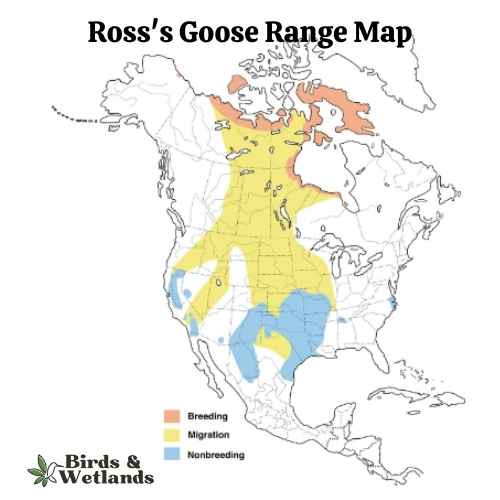
Listen
Scientific Name: Anser rossii
Length: 23.2-25.2
Wingspan: 44.5-45.7 in
Weight:42.3-55.3 oz
The Ross’s Goose is a small species of waterfowl often found in North America’s tundra and wetland habitats.
Appearance: Known for its compact size, the Ross’s Goose is mostly white with black wingtips. It features a short, stubby bill and a rounded head. One key identifying feature is the blueish gray base of its bill, which has a warty structure during the breeding season.
Diet: This goose feeds mainly on vegetation, including seeds, leaves, and roots of grasses and sedges. During winter and migration, they also consume grains and seeds from agricultural fields.
Reproduction: The Ross’s Goose nests on the ground, often in colonies. The female lays a clutch of 2 to 5 eggs which she incubates for around three weeks. The young geese, known as goslings, are precocial – they can walk, swim, and feed themselves shortly after hatching, although they stay with their parents until they learn to fly.
Cackling Goose
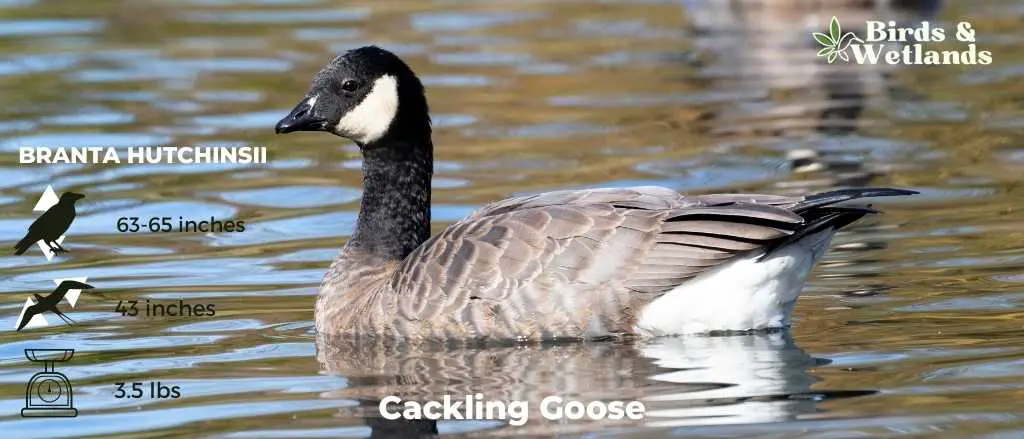
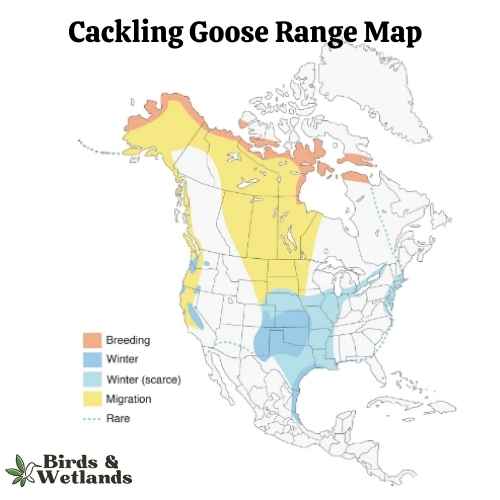
Listen
Scientific Name: Branta hutchinsii
Length: 24.8–25.6 in
Wingspan: 43-45.7 in
Weight:3.5 lbs
Cackling Geese are particularly known for their high-pitched, cackling calls, which is the source of their name. Despite their small size, these geese are renowned long-distance migrants, with some populations traveling thousands of miles between breeding and wintering grounds.
Appearance: With a similar color pattern to the larger Canada Goose, the Cackling Goose features a black head and neck, white chinstrap, light tan to cream chest, and brownish-grey body. One defining characteristic is its noticeably smaller size and stubbier neck compared to its larger counterparts.
Diet: Like many geese, the Cackling Goose’s diet mainly consists of plant matter. This includes grasses, seeds, and aquatic vegetation. They are often seen grazing on land or dabbling in shallow water.
Reproduction: Cackling Geese usually nest on the ground in elevated areas near water bodies, such as riverbanks or lakeshores. The female lays a clutch of 2 to 8 eggs and is responsible for incubation, while the male stands guard nearby. Incubation lasts for about a month.
Greater White-fronted Goose
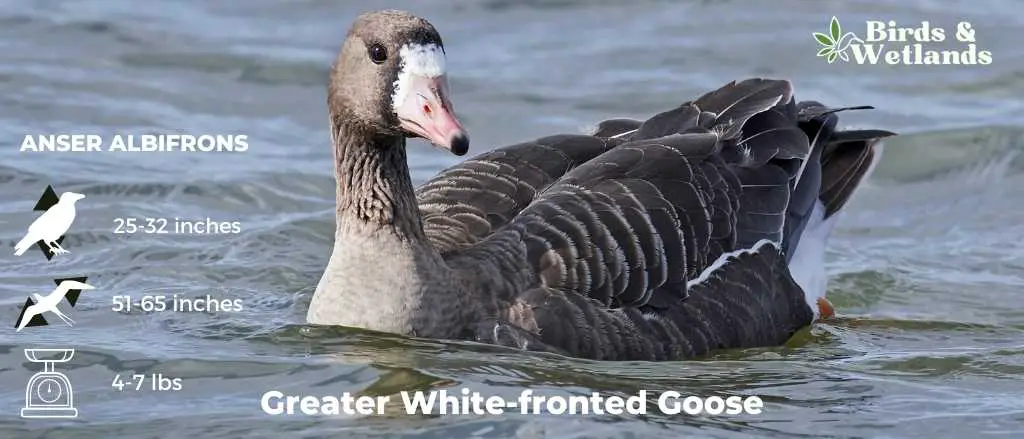

Listen
Scientific Name: Anser albifrons
Length: 25 to 31 in
Wingspan: 53 to 66 in
Weight: 3.3 to 6.6
The Greater White-fronted Goose is a medium to large waterfowl species, widely distributed across the Northern Hemisphere, particularly in North America.
Appearance: As the name suggests, these geese display a prominent white patch at the base of their bill. Their bodies are gray-brown, and their breasts are often marked with dark blotches. They possess a pinkish bill and orange legs and feet.
Diet: The Greater White-fronted Goose is a herbivore and feeds mainly on plant material. Its diet consists of grasses, sedges, grains, and berries. When wintering, these geese can often be found in agricultural fields, feasting on leftover grains and crops.
Reproduction: This species nests on the ground, often in areas with good visibility such as slopes or ridges. The female lays a clutch of 4 to 5 eggs, which she incubates for nearly a month. Once hatched, the young ones are taken care of by both parents until they are able to fly.
Are There Any Resident Flocks of Geese in Kansas?
There are several resident flocks of Canada geese in Kansas.
Canada geese are generally found in the northern and eastern parts of the state, but they can also be found in some southern and western counties.
Canada geese typically inhabit ponds, lakes, and marshes, but they can also be found in fields and farmlands.
Hunting Geese in Kansas
If you’re planning on doing some goose hunting in Kansas, you’ll need to make sure you’re familiar with the state’s regulations.
All waterfowl hunters must obtain a Federal Migratory Bird Hunting and Conservation Stamp (Federal Duck Stamp), Kansas Migratory Waterfowl Habitat Stamp (Kansas Waterfowl Permit) and a Kansas Harvest Information Program Permit (HIP).
Can You Shoot a Goose in Kansas?
In the state of Kansas, hunters are required to use non-toxic shot when hunting any migratory game bird – with the exception of doves and woodcock.
Legal shot types include steel, bismuthtin, tungsten-polymer, tungsten-iron, tungsten matrix, tungsten-nickle-iron, tungsten-iron-nickel-tin, and steel shot coated with copper, nickel, zinc chromate, or zinc chloride.
Here’s the Kansas daily bag and possession limits for goose hunting:
| Daily Bag | Possession | |
| Dark Geese (Canada, cackling, white-fronted, Brant and all other geese except light geese) | 6 | 18 |
| Light Geese (White and blue phase and Ross’ geese) | 50 | unlimited |
Where Can I Hunt Geese in Kansas?
Cheyenne Bottoms Wildlife Area is arguably the best place to hunt geese in Kansas.
The Bottoms are a series of marshes and wetlands that span nearly 41,000 acres in central Kansas. They are home to a variety of waterfowl, including ducks, geese, and shorebirds.
Is There a Goose Hunting Season in Kansas?
Goose hunting season in Kansas is from October to February.
Conclusion on Geese in Kansas
When most people think of Kansas, they probably don’t imagine encountering some of the largest birds in North America.
But if you’re lucky enough to visit a state park like Cheyenne Bottoms or Kanopolis Lake, you may see a few geese or swans swimming by.


